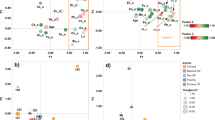Summary
To define the relationship between ionic fluoride concentration in the serum of workers and the amount of hydrofluoric acid (HF) in the work environment, pre-and postshift serum and urine samples of 142 HF workers and 270 unexposed workers were examined. The maximum and minimum concentrations of HF in the air in each workshop varied from the mean by less than 30%. The pre-exposure levels of serum and urinary fluoride in HF workers were higher (P < 0.001) than the control values. This suggests that fluoride excretion from the body continues for at least 12 h. The postshift serum and urinary fluoride concentrations of these workers were significantly higher (P < 0.001) than the preshift concentrations. A good correlation (r = 0.64) was obtained between postshift serum fluoride and postshift urine fluoride. There was a linear relationship between mean serum fluoride concentration and HF concentration in the workshop. A mean fluoride concentration of 82.3 μg/l with a lower fiducial limit (95%, P = 0.05) of 57.9 μg/l was estimated to correspond to an atmospheric HF concentration of 3 ppm. This is the maximum allowable environmental concentration recommended by the Japanese Association of Industrial Health, and it is also the threshold limit value suggested by the American Conference of Governmental Industrial Hygienists. The results demonstrate that exposure to HF can be monitored by determining the serum fluoride concentration.
Similar content being viewed by others
References
American Conference of Governmental Industrial Hygienists (1967) Documentation of threshold limit values. ACGIH, Cincinnati, pp 223–224
Brown MG (1985) Fluoride exposure from hydrofluoric acid in a motor gasoline alkylation unit. Am Ind Hyg Assoc J 46:662–669
Chan KM, Svancarek WP, Creer M (1987) Fatality due to acute hydrofluoric acid exposure. Clin Toxicol 25:333–339
Chatterjec S, Price B (1977) Regression Analysis by Example, Wiley, New York
Czarnowski W, Krechniak J (1990) Fluoride in the urine, hair and nails of phosphate fertilizer workers. Br J Ind Med 47:349–351
Draper NR, Smith H (1966) Applied regression analysis. Wiley, New York
Hodge HC, Smith FA (1977) Occupational fluoride exposure. J Occup Med 19:12–39
Japanese Association of Industrial Health (1964) Documentation of maximum allowable concentrations. Jpn J Ind Health 6:314–315
Kono K, Yoshida Y, Watanabe M, Tanimura Y, Hirota T (1984) Urinary fluoride excretion in fluoride exposed workers with diminished renal function. Ind Health 22:33–40
Kono K, Yoshida Y, Yamagata H, Watanabe M, Takeda Y, Murao M, Doi K, Takatsu M (1985) Urinary excretion of cresol as an indicator for occupational toluene exposure. Ind Health 23:37–45
Kono K, Yoshida Y, Yamagata H, Watanabe M, Shibuya Y, Doi K (1987) Urinary fluoride monitoring of industrial hydrofluoric acid exposure. Environ Res 42:415–420
Kono K, Yoshida Y, Watanabe M, Watanabe H, Inoue S, Murao M, Doi K (1990) Elemental analysis of hair among hydrofluoric acid exposed workers. Int Arch Occup Environ Health 62:85–88
Levi S, Zilberman L, Frumin A, Frydman M (1986) Exposure to fluroide in the chemical industry. Am J Ind Med 47:349–351
Mayer TG, Gross PL (1985) Fatal systemic fluorosis due to hydrofluoric acid burns. Ann Emerg Med 14:149–153
National Institute for Occupational Safety and Health (1975) Criteria for a rommended standard occupational exposure to hydrogen fluoride. In: DHEW/NIOSH Pub No 76-143. Government Printing Office. Rockville p 184
Toyota S, Yoshida Y, Kono K, Harada A (1979) Fluoride content in the urine and serum of hydrofluoric acid operators. Arch Ind Hyg Toxicol [Suppl] 30:957–966
Yoshida Y, Toyota S, Kono K, Watanabe M, Iwasaki K (1978) Fluoride ion levels in the biological fluids of electronic industrial workers. Bull Osaka Med School 24:56–67
Zober A, Geldmacher M, Mallinckrodt V, Schaller KH (1977) Renal fluoride excretion as a useful parameter for monitoring hydrofluoric acid exposed persons. Int Arch Occup Environ Health 40:13–24
Author information
Authors and Affiliations
Rights and permissions
About this article
Cite this article
Kono, K., Yoshida, Y., Watanabe, M. et al. Serum fluoride as an indicator of occupational hydrofluoric acid exposure. Int. Arch Occup Environ Heath 64, 343–346 (1992). https://doi.org/10.1007/BF00379544
Received:
Accepted:
Issue Date:
DOI: https://doi.org/10.1007/BF00379544




